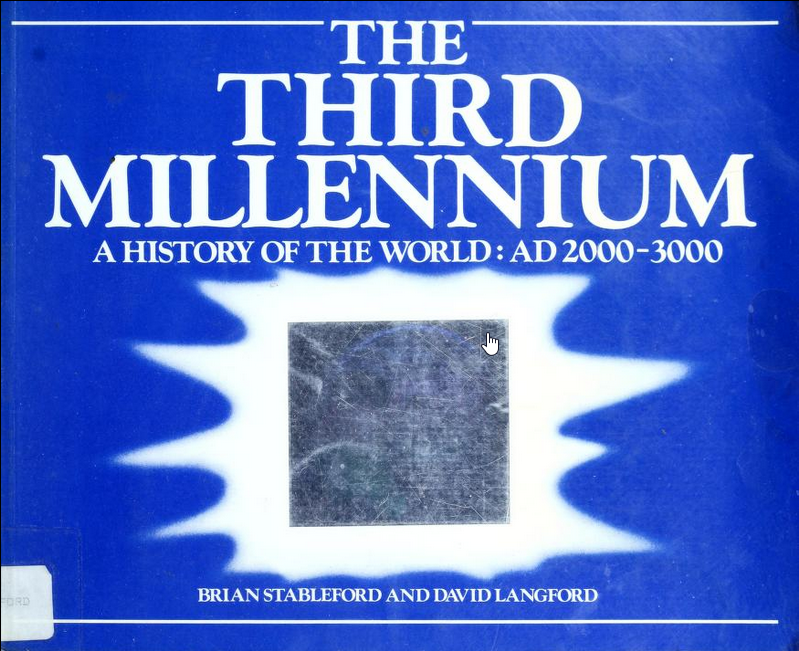Recent Articles
- Art
- Articles
- Cheese
- Chemistry
- Christmas
- Cleberty
- Devil's List
- Economics
- Farmers
- Feedback
- George Orwell
- Golden Whip of Unusualness
- Good Words
- Homebrew
- Inventory
- Lady C-3PO
- Location
- Mail Harry
- Methods of Escape
- New Computer Smell
- New Years Resolutions
- Omega Kitty
- Padiddle
- Pataphor
- People Who Don't Live in Cardboard Towns
Link To The Encyclopedia


|
| This website and its contents are licensed under a Creative Commons Attribution-ShareAlike 4.0 International License |
The Third Millennium

The Third Millennium by Brian Stableford and David Langford
When I was a wee lad sometime in the early nineties, I was browsing the stacks of my local library and found this book tucked away on a wrong shelf. It immediately piqued my interest, mainly because it had a cool hologram of a nautilus shell on the cover.
Eventually, I tore my eyes away from the hologram and started reading what was inside. It's laid out something like a history book, but telling the history of the next thousand years. This freaked my innocent little bean. I was a little nerd that could have recited all manner of lore from Star Wars or Star Trek, but for some reason the idea of a book that was just a somewhat dry telling of a thousand years of speculative future never occurred to me. I never considered the idea that somebody could just sit down and write a book like this, just cover to cover self-indulgent worldbuilding.
I did not check the book out to read it thoroughly, but I skimmed across it and found the future it sketched out to be compelling, especially where it details future technologies and how they affect society.
Later on I would discover tabletop source books, which also often delve into this level of worldbuilding, but by then it was too late. I was already convinced that spending my time thinking up elaborate worlds for no particular reason was a reasonable thing to do.
Anyway, some 30 years later I finally got my own copy of this book, and sadly, I don't find it holds up to adult scrutiny. It was published in 1985, which turns out to have been a profoundly bad year to make predictions about the future. Biotechnology and biological/chemical warfare play a big role int the near future as told by the book, but very little is made of the future of computing and digital networks. One section on a series of "plague wars" ends with noting that one of the last big plagues (described as three separate pathogens that operate together) was easily shrugged off by the US medical system, without any explanation as to how.
Some attention is paid to the looming energy/climate crisis, but mostly about Peak Oil and how eventually the amount of energy needed to extract fossil fuels will approach the energy produced by them. Weirdly, not much is said about any kind of climate change or renewable energy, instead societies are expected to embrace energy austerity until finally Fusion shows up to solve all our energy needs. Boring.
Perhaps the biggest miss is the insistence that both the United States and the USSR would persist hundreds of years into the future, as well as the idea that the United Nations would continue to grow in power until it is eventually overcome by growing cyberpunk-flavored megacorporations.
The later parts of the book are more interesting, mostly because they get back into plausible sci-fi territory on topics that haven't been proven to be laughably wrong, though the section on the advent of artificial intelligence is getting more silly. It turns out that after several different "talking head" AIs are built, the secret to finally getting one legally accepted as a person is... building it a full body.
Oh, also, Mars briefly gets taken over by incels, which may yet be the most prescient prediction of all.
Lastly, the book has pictures but they're pretty much all stock photos that can mostly be passed off as depictions of future objects and events, to varying degrees of success. Better art direction with illustrations or bespoke photos could have done more to sell the "future history book" concept.
I wouldn't recommend anyone else seek out this book, I treasure my copy purely for sentimental reasons. It is a fun bit of speculative fiction that ends up reflecting its own present rather than any actual future, but then again isn't that every work of speculative fiction?